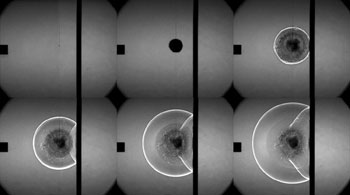High-speed imaging of shock waves could result in improved performance of supersonic jets.
Dr. Johannes Hesper and Dr. Kinko Tsuji, Shimadzu Europa GmbH
A high-speed camera is a necessary tool for studying phenomena such as flying projectiles and explosions. In the case of explosions, dramatic pressure increases result in strong pressure waves, commonly referred to as shock waves (Figure 1). These waves move more quickly than sound, and capturing them on camera as they unfold remains a technical challenge.

Figure 1. Propagation and reflectance of a shock wave are shown at 500,000 fps.
Such imaging is of particular interest to the aeronautics industry. Knowledge of the origin and propagation of shock waves is critical to understanding how they arise on the wings of supersonic jets and how these waves proliferate. When airplanes fly faster than the speed of sound (sound velocity is 343 m/s = 1225 km/h at 20 °C air temperature), the resulting shock waves exhibit numerous additional effects. Visualizing shock waves to study their propagation and effects is the focus of ongoing aeronautics research.
Such information could be used to engineer differently shaped wings for supersonic jets or to refine the design of jet engines.
These processes, when air or other transparent media such as gases or water change the density of the medium, can be viewed with a set of techniques known as density-sensitive visualization methods. In general, a light beam of known properties is sent through the medium, and the changes that this beam experiences are recorded. So-called “shadow” and Schlieren methods record the displacement and the deflection angle of the modified light beam, whereas interferometry techniques monitor the change in optical path length. The Mach-Zehnder (MZ) interferometer was devised more than a century ago by Ludwig Mach and Ludwig Zehnder and historically is the first so-called reference beam interferometer used extensively for fluid mechanics research.
Intended and conceived for whitelight interference, the instrument must be designed, built and adjusted with extreme precision. In the 1960s, the advent of holographic interferometry reduced the importance of the MZ interferometer for flow visualization. However, the instrument has significant advantages that to date have not been achieved — let alone surpassed — by other systems. One of these was demonstrated vividly in a recent test series conducted at the shock wave laboratory located at RWTH Aachen University in Germany.1
That research sought to record the dynamic behavior of shock waves exiting from an open-end shock tube (with an inner diameter of 20 mm) and to gauge the influence of various exit geometries and different shock Mach numbers. When leaving the tube, the shock wave (with an initial shock speed in the tube of about 465 m/s, corresponding to a shock Mach number of 1.35) quickly attains a hemispherical shape and continues expanding at a velocity of ~370 m/s — slightly higher than the speed of sound (Figure 2).

Figure 2. Upon leaving the tube (from left to right), a shock wave (with an initial shock speed in the tube of about 465 m/s, corresponding to a shock Mach number of 1.35) attains a hemispherical shape.
A 514-nm argon-ion laser that produced approximately 1.4 W was used during the experiments. In this case, the light output was strong enough to obtain video sequences with rates of 1 million fps with an individual frame exposure time of 250 ns and a gain factor of unity. In this way, it was possible to obtain time-resolved interferograms of compressible flows with frame rates in the megahertz range.
All of the described features generate density changes in the flow. They appear as dark and bright fringes if the instrument is run in the so-called infinite fringe adjustment. In this case, as well as for a 2-D plane or axisymmetric flow, each fringe represents a contour of constant density. The density increment between two fringes is given by the properties of the light that is used and by the transparent medium as well as through the geometry of the test section. Therefore, it is possible to obtain quantitatively the history and time development of the density distribution from the recorded video sequences in a complex, compressible flow.
The obtained sequences showed that density fluctuations within the vortex ring actually had frequencies close to 1 MHz, so proper representation and quantitative evaluation of these processes required a high-speed camera with the recording properties of the Hyper Vision HPV-1 manufactured by Shimadzu Corp. of Tokyo. The camera can record speeds of up to 1 million fps with high spatial resolution independent of recording speed.
This unique combination of the MZ interferometer and the ultrahigh-speed video camera has yielded previously unachievable results, and the combination of these two instruments holds promise for the future investigation of other processes in compressible flows such as shock wave focusing or wave diffraction around obstacles.
Meet the authors
Johannes Hesper and Kinko Tsuji are product specialists for Shimadzu Europa in Duisburg, Germany; e-mail: [email protected]; [email protected].
Acknowledgment
Dr. Harald Kleine, School of Aerospace, Civil and Mechanical Engineering, University of New South Wales/Australian Defence Force Academy, Canberra, Australia, and Dr. Herbert Olivier, Shock Wave Laboratory, RWTH Aachen University, Germany.
References
1. H. Kleine et al (2008). Time-resolved Mach-Zehnder interferometry of shock waves exiting from an open shock tube. ISFV13, submitted.